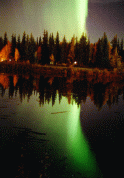
Introduction
The aurora borealis, also known as the northern lights, is a
glowing or flickering light of natural origin which is sometimes seen at night
in the sky. It is nature's light
show which has filled people with wonder, inspired artists, and even frightened
people to think that the end of the world is at hand. 
Aurora borealis occurs in the sky of the northern hemisphere.
The same phenomenon however also occurs in the southern hemisphere, where it is
named the aurora australis. Each
aurora is visible over an area centring around the geomagnetic pole of its own
hemisphere. The aurora borealis is
said to occur with greatest frequency along a line extending through N Norway,
across central Hudson Bay, through Point Barrow, Alaska, and through N Siberia.
It is often visible in Canada and the N United States and is seen most
frequently at the time of the equinoxes.
The aurora occurs higher in the atmosphere than the highest
jet plane flies. The lowest fringes are at least 40 miles above the Earth, while
the uppermost reaches of the aurora extend 600 miles above the Earth.
 The aurora is thought to be caused by high-speed electrons
and protons from the sun, which are trapped in the Van Allen radiation belt high
above the earth and then channelled toward the polar regions by the earth's
magnetic field. These electrically charged particles drop out of the inner
radiation zone and collisionally excite and ionize atmospheric gases (chiefly
oxygen and nitrogen). As these
excited gases return to their stable forms, visible light is emitted with
characteristic colours. Near the
600-mile level, light may also be given off by electrons and protons combining
to form hydrogen atoms.
The aurora is thought to be caused by high-speed electrons
and protons from the sun, which are trapped in the Van Allen radiation belt high
above the earth and then channelled toward the polar regions by the earth's
magnetic field. These electrically charged particles drop out of the inner
radiation zone and collisionally excite and ionize atmospheric gases (chiefly
oxygen and nitrogen). As these
excited gases return to their stable forms, visible light is emitted with
characteristic colours. Near the
600-mile level, light may also be given off by electrons and protons combining
to form hydrogen atoms.